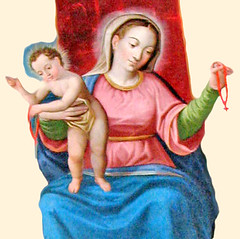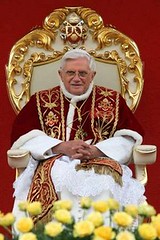POSTS FOR THIS WEEKEND HAVE BEEN POSTED IN ADVANCE AS I AM IN THE DOMINICAN CONVENT AT STONE FOR A YOUTH 2000 RETREAT. Please scroll down for the relevant day's post.

In honour of our holy sister, St Catherine of Siena, below is a brief presentation of some of the spiritual themes and ideas revealed to her. Her teaching on prayer and her compassion and love for others, her concern for truth and her desire to spread the truth of God's love - the preaching service of her letters and writings - are all firmly Dominican traits and she remains a great teacher of Dominican spirituality, a spirituality that all Christians can learn from and draw upon:
"Fra' Guy Bedouelle, OP identifies four great prayers and concerns in her Dialogue: Firstly, for herself; one cannot truly love one’s neighbour unless one first loves oneself, and both are grounded in God’s love and the knowledge of Him. In the Dialogue, God tells her that one moves “from the knowledge of me [God] to the knowledge of oneself, from love of me to love of one’s neighbours.” We see this too in Catherine’s life – first the years spent in solitude and contemplation, growing in love and knowledge of God and then her emergence into the world and a life of passionate service to her neighbour – the sick, dying, troubled. And this love of neighbour, giving without return is only possible is one “draw[s] your love from God who is the fountain of living water, if you do not drink it continually in God, your vessel will soon be empty.” Clearly then contemplation of God drives and replenishes her service of others.
With regard to knowledge of self, it is the foundation of humility. When we know ourselves as we really are, we become aware of our nothingness and our need for God. Catherine says that we come to know ourselves not by looking at ourselves but at God for it is from God that we receive our very being and so God is all in all. Thus the Lord says to her: “Catherine. I am who am; you are she who is not.” All existence is predicate on God and it is this self-knowledge that humbles us and takes us from self-love to love of God who gives us being. Hence, our self-knowledge is dependent on a true knowledge of Him. Thus, we are invited to look at the “gentle mirror” of God – a beautiful image of our human dignity and God’s presence and gentleness.
Catherine comes to this knowledge of God through prayer and meditation. In particular, her own interior (mystical) experiences are God’s revelation to her of his love. Thus she writes: “In your light you enlighten me so that I am able to know your truth. You are the light above all light, who illumines the eyes of my mind with such fullness and perfection that you give clarity even to the light of faith.” As such Catherine attributes her knowledge of God and the fruit of her meditation to the action of God; to His enlightenment of her mind. It is this that she shares with us in her writings.
With regard to mystical union, Catherine describes it as an experience or awareness of the presence of God in the soul and it is quite different from the simple union with God through sanctifying grace. In the state of perfection the soul never loses its awareness of God’s presence; there is such an intimate and continual union between the soul and God that every time and place is a place for prayer, for communing with God; this place she called the “cell of self-knowledge”, the “cell of the heart” and interior cell.
With regard to prayer, Catherine writes in a letter to her niece (Sr Eugenia) of the threefold way of prayer. First there is prayer of the heart, namely, continual prayer, or that constant and holy desire that keeps one in the presence of God. In saying this, Catherine echoes St Augustine who said that first of all, one’s prayer is one’s desire. Secondly there is vocal prayer, especially in the Divine Office, wherein our heart must be in accord with our tongue. Thirdly, there is mental prayer in which “the soul unites itself to God in a movement of love. Rising above itself through the light of its intelligence, it sees; it knows and clothes itself in truth.”
This movement of love has three stages in the growth of a person in holiness. St Catherine calls it servile love (a love accompanied by fear of punishment for one’s sins), mercenary love (a love accompanied by hope of eternal reward) and filial love (the love of God for his own sake, which is the perfection of charity). In this final state of filial love, the individual’s will in entirely united and abandoned to the divine will. The image she uses is of God as a “deep sea” and just as a person dives into the depths of the sea, so “the soul who plunges totally into God is so transformed into God that all her thoughts, understanding, love and memory are taken up exclusively with God and are busy with God alone.”

Catherine’s second great concern was a love for the Church and this love fired her zeal for reform in the Church. Even this love for the Church is fuelled by her passion for Christ.
Indeed, Catherine’s spirituality is deeply Christocentric and she has an interesting image of Christ as a Bridge. In her Dialogues, she writes: “I [God] give you a bridge, my Son, so that could cross over the river, the stormy sea of this darksome life, without drowning.” We need to walk along this bridge to reach our goal. The bridge is “walled and roofed with mercy”, typical of Italian urban bridges. I think of the Ponte Vecchio in Florence which has shops and homes on either side of a broad street, spanning the Arno. One can find refreshment in these shops just as we find refreshment in the sacraments and the Eucharist.
It is said that Catherine’s “sense of the dramatic is unparalleled in mystical literature” and this is true from some of the images we have seen so far. Clearly she draws on images familiar to her time and often inspired by nature too. However some images are (initially at least) violent, even frightening and somewhat startling. For example she calls Christ: "O sweet lamb roasted by the fire of divine charity on the stake of the cross!"
For Catherine, the Church is so united to Christ, as His Mystical Body that she said, “the Church is no other than Christ himself.” As such, the sins of Church members and the moral laxity of the Church in her days was a constant concern for her and she described the Church as a bride whose “face is disfigured with leprosy”. In that same vision, she said that it was the prayers and tears of the saints which would ensure Christ’s mercy on the Church and it was “the fault of [God’s] ministers, and of all those Christians who indulge themselves” that the Church was in such a state of schism and turmoil.
 This must have been a tremendous burden for her. In the final year of her life she dragged herself daily to St Peter’s in Rome to pray for the Church which was beset by schism, heresy, infidels in the Holy Land, states in revolt against the Holy See, etc. She used to pray in front of a mosaic of St Peter in a boat being buffeted by high winds. One day as she prayed there, she felt that the boat was lifted out of the mosaic and placed on her shoulders. It was so heavy that she cried out and fell to the ground.
This must have been a tremendous burden for her. In the final year of her life she dragged herself daily to St Peter’s in Rome to pray for the Church which was beset by schism, heresy, infidels in the Holy Land, states in revolt against the Holy See, etc. She used to pray in front of a mosaic of St Peter in a boat being buffeted by high winds. One day as she prayed there, she felt that the boat was lifted out of the mosaic and placed on her shoulders. It was so heavy that she cried out and fell to the ground.
Indeed, she prayed to the Trinity to “have mercy on the world, and restore the warmth of charity and peace and unity to Holy Church. I do not wish you to delay any longer. I beg you to let your infinite goodness constrain you not to close the eye of your mercy.”
We can see from this prayer that Catherine’s third concern was for peace in the world. Hence she busied herself interceding between city states and writing to leaders.
Finally, Catherine had a concern for her friends. In particular she had a deep friendship with of Raymond of Capua. She calls friends those who “love one another very closely with a singular love” and she sees friendship as a means given to us by God to help us and others to grow in holiness and grace. Hence she looks out for the spiritual welfare of her friends and prays for them: "I commend to you [Father] those whom you have put on my shoulders. You commissioned me to keep them awake, me, who am always sleeping. Wake them up yourself, kind and compassionate Father, so that the eyes of their understanding may always be wide awake in you.""
Associating ourselves as friends of hers, we can be sure that St Catherine of Siena still prays for us and for God's Holy Church. Today is also ordinarily the feast of
St Pius V, Dominican friar and Pope and we ask him to pray for us too that he may draw all Christians into the unity of the Church that we may offer to God a universal hymn of praise and glory and so be brought into the communion of all the saints!
 In honour of our holy sister, St Catherine of Siena, below is a brief presentation of some of the spiritual themes and ideas revealed to her. Her teaching on prayer and her compassion and love for others, her concern for truth and her desire to spread the truth of God's love - the preaching service of her letters and writings - are all firmly Dominican traits and she remains a great teacher of Dominican spirituality, a spirituality that all Christians can learn from and draw upon:
In honour of our holy sister, St Catherine of Siena, below is a brief presentation of some of the spiritual themes and ideas revealed to her. Her teaching on prayer and her compassion and love for others, her concern for truth and her desire to spread the truth of God's love - the preaching service of her letters and writings - are all firmly Dominican traits and she remains a great teacher of Dominican spirituality, a spirituality that all Christians can learn from and draw upon:This must have been a tremendous burden for her. In the final year of her life she dragged herself daily to St Peter’s in Rome to pray for the Church which was beset by schism, heresy, infidels in the Holy Land, states in revolt against the Holy See, etc. She used to pray in front of a mosaic of St Peter in a boat being buffeted by high winds. One day as she prayed there, she felt that the boat was lifted out of the mosaic and placed on her shoulders. It was so heavy that she cried out and fell to the ground.








1 Comments:
Happy feast day Catherine of Siena to all the brothers and sisters in the Dominican Order! a friend from Chile, Southamerica
Román Torres
Post a Comment
<< Home